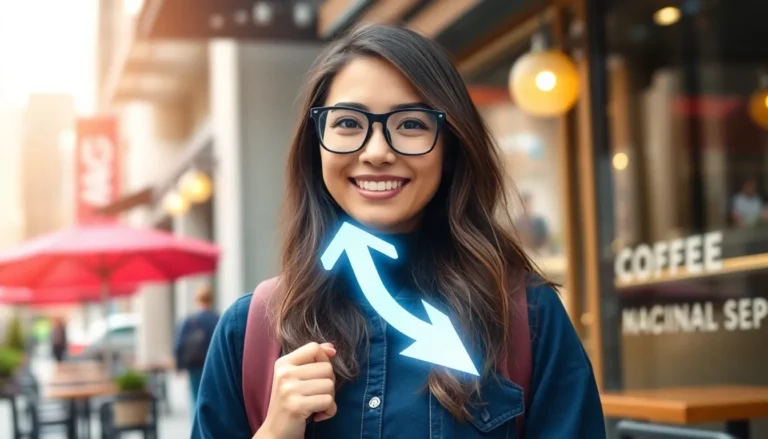Table of Contents
ToggleIn a world where creativity often takes a backseat to deadlines, AI generators are the superheroes we didn’t know we needed. Imagine having a brainstorming buddy that never runs out of ideas, doesn’t need coffee breaks, and can churn out content faster than you can say “writer’s block.” These digital wizards are transforming the way we create, making it easier than ever to bring ideas to life.
Overview of AI Generators
AI generators play a crucial role in various creative fields. These tools harness advanced algorithms to produce content quickly and efficiently. Creators often utilize AI generators for brainstorming ideas, drafting text, or generating images and music. Many industries benefit from their ability to enhance productivity and foster innovation.
The integration of AI generators can significantly reduce the time spent on initial drafts. Designers may rely on these systems to create unique visual content at a fraction of the time it would take manually. Writers frequently employ AI-generated texts to break through creative barriers, allowing for more efficient workflows.
Examples of popular AI generators include OpenAI’s GPT models and tools like DALL-E for art generation. These innovations improve outputs by analyzing vast datasets, learning patterns, and applying them to new contexts. As AI technology evolves, its applications expand, making it an essential part of modern creative processes.
Creatives often find AI generators not just helpful but transformative. They provide invaluable support when faced with tight deadlines and high expectations. Adaptation to these tools has resulted in enhanced artistic freedom and capacity for experimentation. Many users report increased satisfaction in their creative endeavors with AI assistance.
Overall, the importance of AI generators cannot be overstated. They have revolutionized the way individuals approach creativity, turning challenges into opportunities for exploration and innovation. Embracing these technologies transforms the creative landscape, allowing for limitless possibilities and solutions.
How AI Generators Work

AI generators rely on complex algorithms and machine learning techniques to produce creative content. These technologies enable rapid generation and refinement of ideas across various mediums.
Machine Learning Principles
Machine learning forms the backbone of AI generators. It involves training algorithms on vast datasets to recognize patterns and correlations. Training data consists of text, images, and sounds, allowing the systems to learn context and structure. Techniques such as supervised learning use labeled data to improve accuracy. Unsupervised learning enables discovery of hidden patterns without predefined labels. Reinforcement learning, in contrast, optimizes outcomes based on feedback. These principles equip AI generators to create relevant and coherent results.
Key Algorithms Used
Several key algorithms drive AI generators’ performance. Natural Language Processing (NLP) facilitates understanding and generating human language. Generative Adversarial Networks (GANs) enhance image and audio generation through two competing networks. Transformer models, like GPT, optimize context and coherence in text generation. Decision trees and neural networks provide structures for making predictions based on input data. Such algorithms contribute to the effectiveness of AI tools, enabling them to produce high-quality content tailored to user needs.
Applications of AI Generators
AI generators find applications across numerous fields, enhancing creativity and efficiency.
Art and Design
AI generators streamline the process of creating artwork and graphics. Designers harness AI tools to experiment with color palettes and styles, rapidly producing unique images. Algorithms analyze existing visual data, allowing the generation of innovative designs that inspire artists. Tools like DALL-E empower users to create intricate visuals from textual descriptions, expanding creative possibilities. Many artists leverage these technologies to overcome creative blocks, offering fresh perspectives and ideas. AI assistants can even adapt to specific artistic preferences, ensuring outcomes align with the desired aesthetic. Enhanced collaboration occurs when creators pair their insights with AI capabilities, resulting in compelling and original artwork.
Content Creation
AI generators transform content creation by providing substantial support in writing. Writers utilize these tools to draft articles and stories quickly, generating ideas that spark inspiration. Natural Language Processing algorithms analyze text patterns, enabling the production of coherent content tailored to various topics. Incorporating AI writing assistants into the workflow boosts productivity significantly, as they handle mundane tasks. Many bloggers and marketers depend on these technologies to refine their messaging, ensuring clarity and engagement. Time-saving benefits stand out, allowing creators to focus on more strategic aspects of content development. Enhanced brainstorming sessions become the norm when teams integrate AI to generate diverse ideas and viewpoints.
Advantages and Disadvantages
AI generators present various advantages and disadvantages within creative fields. Understanding both aspects helps users maximize their effectiveness.
Benefits of AI Generators
Creatives benefit from the speed at which AI generators produce content. These tools assist in brainstorming and drafting, which enhances productivity significantly. Innovations in Natural Language Processing enable writers to overcome blocks by suggesting phrases or structures. Furthermore, designers tap into AI’s ability to generate unique images from simple textual prompts, allowing for greater experimentation. Art projects become less daunting as AI tools provide endless inspiration. Ultimately, the pressure from tight deadlines lessens, giving artists room to explore their visions.
Limitations and Challenges
Despite their advantages, AI generators face limitations. Quality control remains a concern, as generated content might lack depth or originality. Users often encounter challenges when integrating AI outputs with their unique styles, which can create friction in the creative process. Misinterpretation of prompts may lead to irrelevant or inaccurate results, hindering effective collaboration. Additionally, ethical considerations arise regarding copyright and ownership of AI-generated works. Balancing the use of these tools with traditional methods can sometimes feel overwhelming for creatives.
Future of AI Generators
AI generators are poised to undergo significant advancements, enhancing their impact on creativity. Future developments may incorporate more sophisticated algorithms that improve the quality of generated content. Natural Language Processing advances contribute to more nuanced and context-aware outputs, making interactions with these tools even more intuitive.
Increases in processing power enable AI generators to analyze larger datasets, refining their understanding of human creativity. As these tools evolve, they will likely feature better customization options, allowing creators to set parameters that align more closely with their unique styles.
Industries adopting AI generators can expect enhanced collaboration between humans and machines. Artists might benefit from tailored suggestions, providing inspiration based on their previous works. Writers could receive real-time assistance, ensuring a seamless flow of ideas and narratives.
Privacy and ethical considerations will likely become focal points as AI-generated content permeates various fields. Regulations may emerge to address copyright issues and ensure creators maintain ownership over their works. Balancing innovation with ethical standards remains essential for fostering trust in these technologies.
Training methodologies may shift towards more inclusive datasets, promoting diversity and representation within generated content. This shift can enrich the creative landscape by reflecting a broader spectrum of ideas and cultural influences.
As AI technology continues to progress, the integration of AI generators into creative workflows will redefine traditional practices. Creatives embracing these innovations can expect to unlock unprecedented levels of productivity and inspiration, transforming their approaches to art and expression.
AI generators are reshaping the landscape of creativity by offering tools that enhance productivity and inspire innovation. They serve as essential companions for artists and writers navigating tight deadlines and creative blocks.
As technology continues to advance, the potential applications of AI generators will expand, fostering deeper collaboration between humans and machines. Creators can expect a future where these tools provide even more tailored and context-aware outputs.
With ongoing developments in algorithms and ethical considerations, AI generators are set to redefine creative workflows, unlocking new avenues for exploration and artistic expression. The journey of creativity is evolving, and AI is at the forefront of this transformation.







